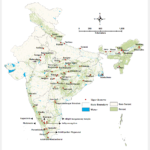Last rhinos translocated in Assam under Vision 2020 to increase population

Two rhinos—one adult male and one female—were released in the central part of Bansbari range of Manas National Park (MNP).
The rhinos were transported from the Pobitora Wildlife Sanctuary
Launched in 2005, the Indian Rhino Vision 2020 aimed to boost the population of rhinos in Assam State and expand the species’ range , at least 3,000 greater one-horned rhinos within the state from three protected areas to seven. Manas National Park was the first to receive translocated rhinos.
Seven protected areas are Kaziranga, Pobitora, Orang National Park, Manas National Park, Laokhowa wildlife sanctuary, Burachapori wildlife sanctuary and Dibru Saikhowa wildlife sanctuary.

There are three species of rhino in Asia — Greater one-horned, Javan and Sumatran. Javan and Sumatran Rhino are critically endangered and the Greater one-horned (or Indian) rhino is vulnerable In IUCN Red List.
They are spread across India, Nepal, Bhutan, Indonesia and Malaysia. These countries are also known as Asian Rhino Range Countries.
Only the Great one-horned rhino is found in India.
At present, there are about 2,600 Indian rhinos in India, with more than 90% of the population concentrated in Assam’s Kaziranga National Park.
- All rights of people within a National Park have to be settled while rights over land can be allowed inside a Sanctuary.
- Grazing of livestock can be permitted inside a Sanctuary but not inside a National Park.
- A Sanctuary can be upgraded as a National Park. However, a National Park cannot be downgraded as a Sanctuary.
- People can collect firewood, fruits, medicinal plants and other stuff in small scale from the sanctuary. But the park can not be used for any reason like fruits, firewood etc.







0 Comments